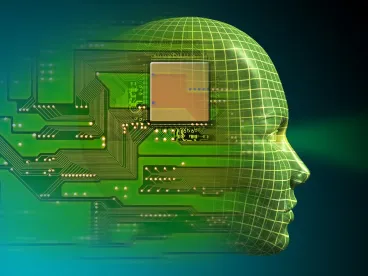We previously discussed which portions of an artificial intelligence/machine-learning (“AI/ML”) platform could be patented or protected under trade secret, such as related to biotech and synthetic biology. Equally important to the discussion of how to protect components of an AI/ML platform, however, is the extent to which copyright protection may be useful or beneficial to the developer of the platform. In this post, we explain what can be protected by copyright in an AI/ML platform. We also explore when it is appropriate to protect portions of AI/ML platforms using a copyright, how to properly enforce copyrights, as well as when to consider using copyright protection over patent or trade secret protection.
What Can be Protected by Copyright in an AI/ML Platform
Copyright allows an entity to protect tangible, original, and reproducible works, such as music, films, photographs, books, software code, and websites. Rather than protecting ideas or processes in protectable works, copyright can protect how ideas are expressed (including protecting how information is organized and structured in a body of work, or how information is conveyed in software code). Copyright owners enjoy many exclusive rights to their work, including the right to reproduce, distribute, perform, and display their work. Copyright protection can last several decades, far surpassing the period of time that a patent may be enforceable.
Copyright law affords protection for many components of an AI/ML platform, from the software itself to data used within the platform. For example, a copyright on source code can prevent others from reproducing the source code verbatim to use or distribute to others, reproducing the source code in a different computer language, and (in some circumstances) reproducing features of the source code (such as structure or non-functional features of the source code), even if not copied verbatim from the protected source code. Many companies have successfully protected their software from others using copyright protection. See, e.g., Microsoft Corp. v. Buy More, Inc., 703 Fed. Appx. 476, 2017 U.S. App. LEXIS 11454, 2017 WL 2790693 (where a court granted Microsoft $1,950,000 in statutory damages upon a summary judgment determination that Buy More had infringed Microsoft’s copyright on Windows 7 and Office 2007); Oracle America, Inc. v. Envisage Technologies, LLC, No. 3:21-cv-03540 (N.D.C.A), and Oracle America, Inc. v. NEC Corp. for America, No. 5:21-cv-05270 (N.D.C.A) (where Oracle reached settlements in less than a year in both cases); Whelan Assocs. v. Jaslow Dental Lab., Inc., 797 F.2d 1222 (3rd Cir. 1986).
Unlike with patents, there are no subject matter eligibility requirements to obtain copyright protection for software; copyright protection can also cover characteristics of the software that cannot be protected by patents, such as how an algorithm is expressed in source code. In instances where an AI/ML platform is patent-ineligible or where the value of the platform does not only rely on the underlying algorithms implemented in source code, copyright protection can be a suitable alternative.
Many other components of an AI/ML platform may also be protected by copyright. For example, if an entity takes photographs that are subsequently used as training data, the photographs may be copyrightable. An entity may also obtain copyright protection over a compilation of data that, by nature of its arrangement, selection, or similar characteristics, is creative or original. See 17 U.S.C. § 103 (noting that compilations can be protected by copyright); but see Feist Publications, Inc. v. Rural Telephone Service Co., 499 U. S. 340 (1991)(where a telephone book was not copyrightable because the telephone information was uncopyrightable facts and the way in which the information was selected and arranged was unoriginal). Another example includes an AI/ML platform that uses training data generated from stock images that are publicly available or obtained from a third party. The specific compilation of images that it selects for training sessions can potentially be protected by copyright, even if the company cannot obtain a copyright on the images themselves.
How and When to Protect Copyrightable Material
A qualifying work is automatically protected by copyright once it has been created; a software developer obtains exclusive right to their software code, for example, the moment it has finished drafting the source code for the software. However, the developer cannot sue others for copyright infringement using this automatic right alone. The Copyright Act requires registration with the U.S. Copyright Office to enforce a copyright against others. See 17 U.S.C. §§ 411(a), 501(b). To register a copyright, an applicant can file an application for registration with the U.S. Copyright Office and include a copy of the copyrighted work. After a review of the work and application, the Copyright Office can register the copyright and issue a confirmation to the owner, allowing the owner to then enforce their copyright in legal actions against infringing parties. In some limited circumstances, an applicant can pre-register their work to allow the copyright owner to file copyright infringement suits while waiting for the Copyright Office to register the copyright. Once registered, owners are encouraged (but not required) to provide notice to others as to their copyright, e.g., by placing a copyright notice within the work.
The Copyright Act also requires an entity to register their copyright within three months of its first publication or within a month of learning of an infringing act, to obtain statutory damages or attorney’s fees. See 17 U.S.C. § 412. A failure to seek copyright registration early can close off the possibility of obtaining statutory damages and attorney’s fees entirely. See e.g. Southern Credentialing Support Services, L.L.C. v. Hammond Surgical Hospital, L.L.C., 946 F.3d 780 (5th Cir. 2020).
A failure to timely register can also result in any lawsuits filed prior to registration being dismissed outright. See, e.g., Fourth Estate Public Benefit Corp. v. Wall-Street.com, 586 U.S. ____ (2019); No. 17-571 (dismissing the plaintiff’s copyright infringement suit, as the Copyright Office had not registered a copyright for the work in question at the time the complaint was filed). As long as an entity registers their copyright within the three-year statute of limitations for copyright infringement, the entity can file a suit against the infringing party, and can also seek non-statutory damages for infringing acts performed prior to the date of registration that fall within the statute of limitations timeframe. See id., slip op. at 10.
It is therefore imperative to think about copyright protection prior to public disclosure, to preserve these rights in the event that another party infringes the copyright.
Copyright Protection Versus Patent or Trade Secret Protection
In some circumstances, copyright protection may protect portions of an AI system that cannot be protected using patents or trade secrets alone, or can provide supplemental protection not afforded through these other IP rights. Below are some key considerations to keep in mind when deciding what type of protection may be optimal for a particular platform.
Protection Eligibility: As noted in a previous blog post, some aspects of an AI/ML platform may not be patent-eligible, such as the specific source code used to implement the AI/ML platform or the training data for the platform. Trade secret protection may not always be a viable choice for all components of the AI/ML platform, either. For example, if an entity provides an AI/ML model to end users alongside a training data set to use with the model, the training data set may lose its trade secret status once the entity has exposed the data to the end user. The composition of the training data set, however, may still be copyrightable, allowing for protection even if the training data set is exposed to others. Similarly, even if the training data set is not provided directly to the end user, the end user may be able to infer the composition of training data sets through normal use of the software platform. Under these conditions, trade secret protection would not prevent the end user from creating its own training data set after studying the public-facing functionality of the platform, or from distributing their training data set to others. However, the developer may be able to prevent the end user from distributing the training data set using copyright protection, even if it was reversed-engineered through normal use of the platform. Thus, at times copyright protection may better protect aspects of the AI/ML platform compared to trade secrets and/or patents.
Note, however, that there are many components of an AI/ML platform that may not be copyrightable (such as intangible algorithms or processes used to implement the AI/ML platform, unoriginal sets of training data, or output values generated by the algorithms). For example, Oracle learned the hard way in a recent Supreme Court loss that Google’s use of portions of its Java SE API did not constitute copyright infringement. Patents, trade secrets, and copyright can each serve as valuable IP solutions depending on what can and should be protected within the platform.
Effect of Development on Protection: Patent protection grants an exclusive right to the invention as described in the patent owner’s claims, which may cover many different iterations or implementations of the same AI/ML platform. While trade secret protection is not as broad in scope, a developer can protect new iterations or implementations of a platform simply by following the same protocol and procedures to maintain each new iteration as a trade secret. Copyright protection, in contrast, is limited to the scope of the protected work. If there are plans to frequently update or change implementations of the same platform and processes, then patent or trade secret protection can be preferable over copyright protection, as copyright protection may not always afford broad enough protection to include modifications to the platform. On the other hand, if a company has no plans to make any substantive changes to its platform, then copyright protection can be a more cost-effective way to protect aspects of the platform.
Exclusivity: Copyright protection, similar to patents, provides an exclusive right to the protected content; patent protection provides an exclusive right to practice or sell a claimed invention, while copyright protection provides an exclusive right to distribute, reproduce, perform, and otherwise use the work. This protection can sometimes be preferable to trade secrets, which do not provide exclusive rights to protected information.
Conclusion
Copyright protection can allow a company to protect content that is not patent-eligible, through a process that is much less expensive than patent prosecution. Copyright protection can also allow a company to protect information that it cannot protect through trade secrets (i.e., due to potential exposure to other parties through normal use). When assessing what component of an AI/ML platform can be protected, as well as the best forms of protection to use for each component, copyright protection should always be discussed prior to any potential public disclosure and included in discussions alongside patent and trade secret protection to ensure optimal protection of key assets within the platform.




 />i
/>i
